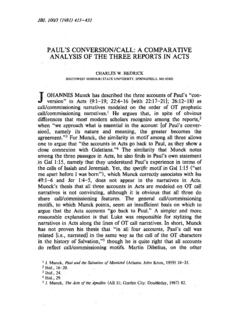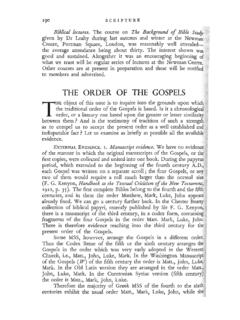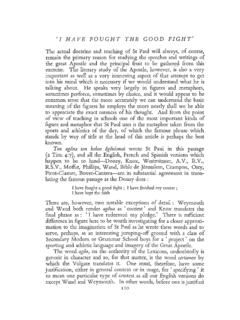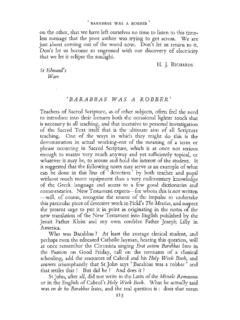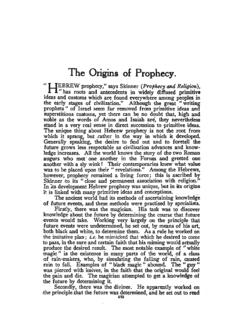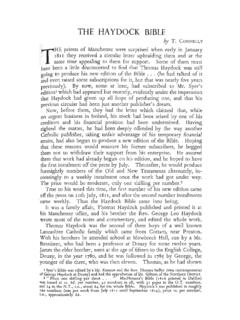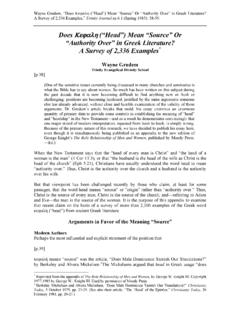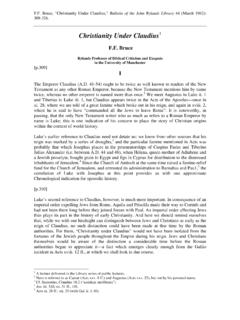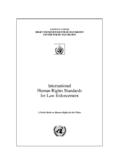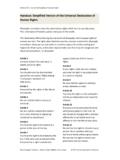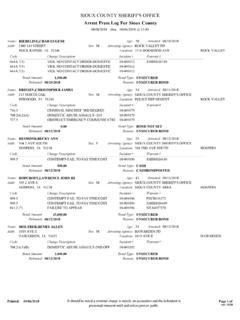Transcription of The “Criteria” for Authenticity - BiblicalStudies.org.uk
1 Robert H. Stein, The criteria for Authenticity , France & David Wenham, eds., Gospel Perspectives, Vol. 1, Studies of History and Tradition in the Four Gospels. Sheffield: JSOT Press, 1980. The criteria for Authenticity Robert H. Stein [ ] It is evident from even a cursory reading of the literature that scholarly attitudes toward the historicity of the gospel materials vary drastically. On the one side we have those scholars who possess a positive attitude toward the gospel materials and state In the synoptic tradition it is the inauthenticity, and not the Authenticity , of the sayings of Jesus that must be demonstrated .1 On the other side we have those who possess an equally negative attitude toward the materials.
2 Clearly, we have to ask ourselves the question as to whether this saying should now be attributed to the early Church or to the historical Jesus, and the nature of the synoptic tradition is such that the burden of proof will be upon the claim to The latter view clearly presumes that the gospel traditions are guilty, historically not true, unless they can be proven innocent. The Burden of Proof The question of the historicity of the gospel materials has been dealt with in a number of ways in the past. One popular method was to evaluate the general historicity of the gospel materials by comparing those historical portions of the gospel materials which have parallels in secular or non-Christian historical records and see whether these records support or tend to deny the historicity of the gospel parallels.
3 By this means perhaps some general attitude might develop toward the accuracy or inaccuracy of the gospel accounts as a whole. Another attempt has been to establish if a gospel writer was an eyewitness to the accounts he records in his Gospel. If he was an eyewitness, then this would lend credence to the historicity of his account. The problems with this approach, however, are two-fold. For one, only two of our [ ] are associated traditionally with eyewitnesses and it is a much debated question as to whether any of them actually were written, as we now find them, by an eyewitness. Secondly, even if they were written by eyewitnesses, this does not in itself demonstrate that what they wrote are accurate historical accounts of the life of Jesus. It does not of necessity follow that eyewitness accounts of historical events are a priori accurate historical accounts!
4 Such accounts are of course, all other things being equal, better historical records than non-eyewitness accounts. We cannot, however, assume that we have proven the historicity of the gospel accounts if we can demonstrate that behind them stands the testimony of an eyewitness. On the other hand it seems logical to assume that, if eyewitness testimony of the gospel materials could be established, then the burden of proof should rest upon those who would deny the historicity of the events reported. 1 Joachim Jeremias, New Testament Theology, trans. by John Bowden (Charles Scribner s Sons, 1971), p. 37. 2 Norman Perrin, Rediscovering the Teaching of Jesus (Harper & Row, 1967), p. 39. Robert H. Stein, The criteria for Authenticity , France & David Wenham, eds.
5 , Gospel Perspectives, Vol. 1, Studies of History and Tradition in the Four Gospels. Sheffield: JSOT Press, 1980. A final example that shall be mentioned with regard to the attempt to establish a general attitude toward the question of historicity and our Gospels is to evaluate the process by which the tradition was preserved and passed on. In this method, sometimes called Form Criticism and sometimes Tradition Criticism,3 various arguments are frequently raised in support of the substantive accuracy of the gospel accounts. Some of those mentioned most frequently are: 1. The existence of the eyewitnesses during this period would have had the effect of seeing that those traditions would be faithfully preserved and that non-historical traditions would not be 2.
6 The existence of a center of leadership (the Jerusalem Church) would have caused the traditions to be passed down carefully and 3. The high view found in the New Testament toward the traditions (cf. Romans 6:17 the church does not preserve the traditions but the. traditions preserve the church; 1 Corinthians 7:10 and 12 note how Paul carefully distinguishes between what Jesus has said about divorce and what he has not said) indicates that during the oral period the traditions were carefully preserved and safeguarded. [ ] 4. The faithfulness of the early church in transmitting various difficult sayings of Jesus (cf. Mark 9:2; 10:18; 13:32; Matthew 10:5) witnesses to the reliable transmission of the gospel materials.
7 5. The view that much of the gospel material was simply created by the early church de novo to meet its religious needs and solve various religious problems is difficult to accept in the light of the fact that several of the major problems that the early church encountered never show up in the gospel materials. Since the first and most important issue that the early church faced was the question of whether Gentile Christians had to be circumcised, one would expect to find some saying of Jesus that dealt with this issue, if the church were creating material to solve certain problems. 6. We must also not forget that the ability to remember traditions and pass them on faithfully is not limited by our present-day inability to do this or to conceive of this. The introduction of cheap writing materials into the world has had a negative impact in that it has paralyzed our abilities to memorize and to use the mind, rather than notebooks and files, as a data-bank.
8 Although the above-mentioned attempts to establish the historicity of the Gospels are worthwhile and provide a general attitude toward the Gospel materials, when we seek to discover what the resultant general attitude is, we find no consensus at all. The present writer believes that the arguments listed above are sufficient to establish that the burden of proof 3 Technically these terms are not synonymous but in practice they essentially are. 4 For the contrary view see: D. E. Nineham, Eye-witness Tradition and the Gospel Tradition, JTS, 9 (1958), pp. 13-25, 143-152, and 11 (1960), pp. 253-260. 5 For this view see: Harald Riesenfeld, The Gospel Tradition and its Beginnings (A.)
9 R. Mowbray, 1957) and Birger Gerhardsson, Memory and Manuscript: Oral Tradition and Written Transmission in Rabbinic Judaism and Early Christianity (C. W. K. Gleerup, 1961). Robert H. Stein, The criteria for Authenticity , France & David Wenham, eds., Gospel Perspectives, Vol. 1, Studies of History and Tradition in the Four Gospels. Sheffield: JSOT Press, 1980. ought to be with those scholars who deny the historicity of the gospel materials. To assume the inauthenticity of the gospel materials, unless proven otherwise, appears to be an extreme skepticism unwarranted both in the light of the various arguments listed above and a violation of a common courtesy every witness A witness should be presumed innocent until proven guilty.
10 Of course, if through the investigation of an account one arrives at a general attitude toward its historical veracity which is negative, then one cannot help but change the burden of proof, so that the historicity rather than the unhistorical nature of the accounts must be demonstrated. For this writer, however, this has in no way been demonstrated with regard to the gospel materials. [ ] Besides these general arguments which are primarily helpful in establishing a general attitude toward the gospel material, there exist certain tools which can be used to ascertain the historicity, or at least the historical probability, of a specific saying, teaching, or action of Jesus found in the Gospels. These tools or rules of thumb have been referred to as criteria by which the Authenticity (or unauthenticity) of certain material can be established.
